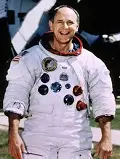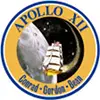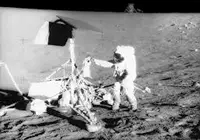Alan Bean was a Navy test pilot and astronaut most well-known for being the fourth person to set foot on the Moon. 
Bean was born on March 15, 1932 in Wheeler, Texas. He grew up in Minden and graduated from Fort Worth's R.L. Paschal High School in 1950. He enrolled in the University of Texas and graduated from there in 1955 with a bachelor of science degree in aeronautical engineering. He had joined the Naval Reserve Officers Training Corps (NROTC) while at university, and he was later assigned for duty at Jacksonville, Fla., and at the Naval Test Pilot school at Patuxent River, Md. (His instructor was Pete Conrad, his future crewmate aboard Apollo 12, the second mission to land people on the Moon. He logged more than 7,100 hours of time in the air. Bean was selected as part of Astronaut Group 3 in 1963. His first assignment was as backup command pilot for Gemini 10. A chance opening on the Apollo 9 backup crew gave Bean his spot in the rotation that eventually resulted in his being part of the primary crew for Apollo 12. 
Before the crew ever left Earth, they encountered a severe challenge. They had launched during a storm, and lightning had struck the Command Module, knocking out the guidance and navigation platform. Saving the day were Bean and John Aaron, a flight controller. Aaron had, for some reason, thought of a similar situation that involved the failure of the power supply to the Signal Conditioning Equipment (SCE). He suggested switching the SCE box to backup mode. Bean alone among the crew knew what Aaron was talking about and flipped the correct switch. The result was a virtual reboot, and the launch continued. Serving as Lunar Module Pilot, he was at the controls as Intrepid, the crew's name for the LM, descended to the lunar surface on November 20. His LM crewmate, Pete Conrad, was first out of the capsule. Bean followed not long afterward, becoming the fourth person to walk on the Moon. While Bean and Conrad completed nearly eight hours of extravehicular activity–including collecting moon rocks and dust and performing various experiments–Command Module Pilot Dick Gordon circled overhead, snapping photos for future lunar missions. 
This crew had carried the first color television to the lunar surface, and that was the camera that was mounted on the exterior of the spacecraft and had broadcast images of Conrad and then Bean descending to the lunar surface. However, they were unable to broadcast in color from the intended tripod site on the lunar surface because Bean inadvertently pointed the camera at the Sun, which zapped the camera's capabilities. They did take a large number of static photographs. After a seven-hour rest, Bean and Conrad flew back to rendezvous with Gordon in the Yankee Clipper (the crew's name for the Command Module). Their return to Earth was without incident. Splashdown was in the Pacific Ocean on November 24. The crew endured quarantine in Houston and were released on December 10. One of Bean's frustrations while on the Moon was that he couldn't locate a self-timer that he had smuggled aboard the spacecraft. He had wanted to take a photo of himself and Conrad together, as a puzzle for scientists to solve as to how it had been taken. When he finally found the timer, he had no time to use it and threw it as far as he could. 
Bean carried on with his astronautics career, serving as spacecraft commander for the Skylab 3 mission, in July–September 1973. He, Owen Garriott, and Jack Lousma were on the space station for 59 days, during which time Bean performed a spacewalk. He was later backup spacecraft commander for the Apollo-Soyuz Test Project, a joint enterprise with the Soviet space agency. He retired from the Navy in 1975 but continued as the one in charge of astronaut training and operations, serving until 1981. Bean next turned his hand to painting. Among the point of difference for some of his paintings is that they contained Moon dust. He used bits of keepsake patches from his spacesuit in his paintings, and the patches had specks of Moon dust in them. He also included lunar boot prints in his works. He became well-known for his paintings of the Moon and surrounds. Among his paintings was the entertainingly titled Rock and Roll on the Ocean of Storms. He exhibited 45 of his works at the National Air and Space Museum in 2009, to mark the 40th anniversary of the Apollo 11 landing. 
Even though the lunar surface was gray, he often added color in order to enhance its depiction. He painted scenes that happened and some that didn't. Among his works was The Fantasy, which showed not only Bean and Conrad in front of Intrepid but also Gordon, who never made it to the lunar surface. Two other works by Bean were The Fabulous Photo We Never Took (right) and Our Little Secret, both of which depicted events surrounding his attempt to take a timed photo on the Moon. Alan Bean died on May 26, 2018. He was 86. He had married twice and had two children. He was interred in Arlington National Cemetery. He was a prolific author as well, writing a number of books, including My Life as an Astronaut, Apollo: an Eyewitness Account, and Painting Apollo: First Artist on Another World. |
|
Social Studies for Kids
copyright 2002–2026
David White




